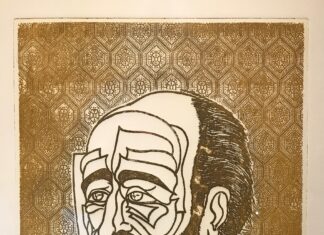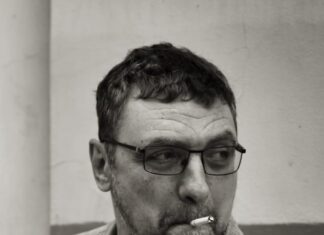And he concludes:
“The play’s the thing
Wherein I’ll catch the conscience of the King.”
Such is the power of theatre. Viewers in the city of Konstanz in Germany had the chance to witness that power on March 21 at the state theatre. The play performed that night was a dramatic rendering of a famous novel about the Armenian Genocide, “The Story of the Last Thought,” written by German-Jewish prize-winning author Edgar Hilsenrath. Days before the premiere, members of the local Turkish community had sent emails to the theatre expressing their outrage at the project. Three days before the opening, the Turkish Honorary Consul Serhat Aksen faxed a letter to the theatre protesting the use of the term “Armenian Genocide” in the play to characterize the events of 1915. He argued that the term depicts an “evident criminal act” but that no legal verdict to that effect existed. “In the face of our full respect for art,” he wrote, according to press reports in German, “we are of the opinion that theatergoers also have the right to receive correct information, and in this respect to learn that the events of 1915 are a theme for legitimate academic debate.”
He went on to demand that his letter be read to the audience or handed out in printed form to them, and also be posted on the website of the theatre.
On the evening of the premiere, a group of about 100 protestors came together to stage a demonstration, waving Turkish flags and raising posters.
What triggered the protest initially and what the demonstrators objected to was the poster that had circulated to advertise the event. It showed the photograph of a corpse on the ground, seen from the shoes and covered with a cloth. Above it was the red Turkish flag, with a quote from Turkish Prime Minister Recep Tayyip Erdogan superimposed, “No genocide was committed in our history.” The consul and citizens of Turkish descent considered this an attack; Armenian actress Bea Ehlers Kerbekian remarked that the poster was in poor taste, and certainly disrespectful towards the victim and his family.
The theatre’s artistic director, Christoph Nix, moved quickly to defuse the situation. He visited the Imam of the Mevlana Mosque in the city, to assure him that no one had intended to offend Muslims or Islam, and said he would pull the poster as well as read the consul’s letter prior to the performance. As one commentator noted, in this way he succeeded in driving a wedge between a hardliner faction (which stayed away) and a moderate group (which demonstrated only against the poster). This was important, given a dangerous precedent: in March 2011 a Social Democratic political candidate of Kurdish and Alevite background, had been brutally beaten and the aggressor never identified. She had proposed political initiatives against a well-known Salafist extremist, considered by the German authorities to be a “hate preacher.” Nix is also a lawyer who has defended Turkish opposition figures, a professor of law and the author of a book on political trials in Turkey — i.e. not an artist who is unaware of political realities. His action served also to protect his actors and theatre.
As a result, the play did go on, albeit under police protection. Needless to say, the house was packed. Among those attending were local politicians, including the city’s mayor, Andreas Osner, responsible for culture and education, and Peter Friedrich, Baden-Wurttemberg State Minister for the Bundesrat, Europe and International Affairs, both from the Social Democratic Party (SPD). On Facebook, Friedrich praised the performance, extolling the excellence of the “superb acting achievement and the ability to draw a large arc, using very simple means, to span cultural characters, political conflicts and personal destinies.” He went on to present his view that “We cannot leave the discussion about the murder, systematic elimination and deportation of hundreds of thousands of Armenians beginning in 1915 to historians alone or to a disposition of punishment according to international law. What is required is society’s active examination of history. This is the only way to develop a good and open democratic culture.” Another State official, Jürgen Walter, lamented the fact that it has become increasingly difficult in Germany to openly discuss such issues, and raised the question, “Who should lead these debates for society then, if even art and culture are no longer allowed to do so?”
The response from the Armenian side was harsher. Father Diradur Sardaryan, head of the 5,000-member Baden-Wurttemberg Armenian Community, who had attended the performance, stated that the “fact of the Ottoman genocide against the Armenians is completely irrefutable internationally. If Turkey continues to deny this crime to the present day, that is a sign of ignorance; if it now, however, demands that history should be falsified also in Germany, then that is simple madness. What we are experiencing here in Konstanz is an absurd battle against history and against artistic freedom.” He thanked Nix for his courage, and said the play was a “sign of hope.” In a statement issued as part of a joint declaration with the community, Dr. Tessa Hofmann, genocide researcher and chairwoman of the Working Group for Recognition, noted that “for forty years” she has witnessed “how Turkish diplomacy in Germany and other states has made massive interventions into artistic, scientific and press freedom.” This occurs, she wrote, by mobilizing “popular rage” in an attempt to intimidate organizers, sabotage events or use them for denialist propaganda. She regretted the fact that often organizers compromise with such pressure.
Both Christoph Nix and Thomas Spiekermann, the dramaturg of the theatre, reasserted their commitment to defend artistic freedom against such intrusions. Accordingly, performances of the play will continue in the next weeks as scheduled. At the same time, they have insisted on maintaining their theatre’s tradition of openness to dialogue. On April 13, they will host a round table discussion with leading German, Turkish and Armenian intellectuals, including Dr. Raffi Kantian of the German-Armenian Society, and Patrak Estukyan from Agos.
And, one might ask, what about the author? What does Hilsenrath, whose novel provided the inspiration for the play, think about all this? Referring to the honorary consul’s attempt to relativize the genocide, he was quoted as saying bluntly, “There is no discussion. It was a genocide.”
Hilsenrath knows whereof he speaks. Born in 1926 in Leipzig, the son of a German-Jewish merchant, he was forced to flee with his mother and brothers in 1938 and seek safety with grandparents in Rumania. In 1941 he was deported to a ghetto in Ukraine, but survived. In 1945 Hilsenrath migrated to Palestine where he stayed until 1947, when he moved to Lyon. In the 1950s he was in New York and in 1975 returned to Germany, where he now resides in Berlin.
His novel, which has been translated into many languages, including Armenian, Russian, French, Italian, English and Turkish, tells the story of the suffering of the Armenians in the form of an oriental fairy tale. It comes as the last thought of Thovma, the dying son of Wartan Khatisian, an Armenian from an Anatolian village destroyed by Turks, who knows nothing of his family history. Then, in accordance with the oriental tradition of storytelling, a Meddah appears to relate his past. He reveals in his tale how Thovma was born the son of an Armenian woman during the deportations. She left him behind in hopes he would survive. The work has won numerous awards, including the Prize from the President of the Republic of Armenia and an honorary doctorate from the State University of Yerevan, which Hilsenrath received in 2006.
The performance in Konstanz, though dubbed a premiere, was actually not the first adaptation of the work for the stage. It was performed in Yerevan in September 2006 and then went on a very successful tour throughout the country. This was a bilingual production, German and Armenian. In November 2006, this version by Andreas Jungwirth held its German premiere in Berlin. A co-production of Bea Ehlers Kerbekian and Gayane Apinyan, directed by Rolf Krieg and ensemble, and with a set designed by artist Archi Galentz, the play was presented at the Theater unterm Dach (Loft Theatre) under police protection. The Armenian archbishop travelled from Cologne for the opening night. When the play was to be revived in March 2007, visa problems prevented the actors from Armenia from coming. Turkish actors were difficult to recruit given the tense atmosphere. One Turkish actor dropped out and Recai Hallaç, who also worked as a translator for the German Foreign Ministry, risked his job to play. He was a personal friend of Hrant Dink, assassinated in January 2007, and he therefore agreed to take the role. He in fact filled the two parts himself. Author Hilsenrath attended almost all the performances. In 2009, the play again went on in Berlin, at the Balhaus Naunynstrasse theatre, this time directed by film maker Miraz Bezar a Kurd. Bea Ehlers Kerbekian again played the role of the Meddah storyteller and two Turkish actors participated. This time, there was no need for police protection; by then, Turkish intellectuals and artists had decided to refuse the denialist policy and to speak out about the genocide. In short, to put on this play has required courage and dedication. In every case, it has had major impact.
In Shakespeare’s drama, Hamlet has his troupe of actors put on his play, which he entitled, “The Mousetrap.” The character Lucianus pours poison into the ear of the sleeping Gonzago, and Hamlet tells the audience that they will soon see how the murderer will get his victim’s wife. “The King rises,” Ophelia says in astonishment, and Claudius, the King, leaves the company in haste, exclaiming, “Give me some light. Away!” In fact: the play’s the thing.
(Muriel Mirak-Weissbach can be reached at mirak.weissbach@googlemail.com)








